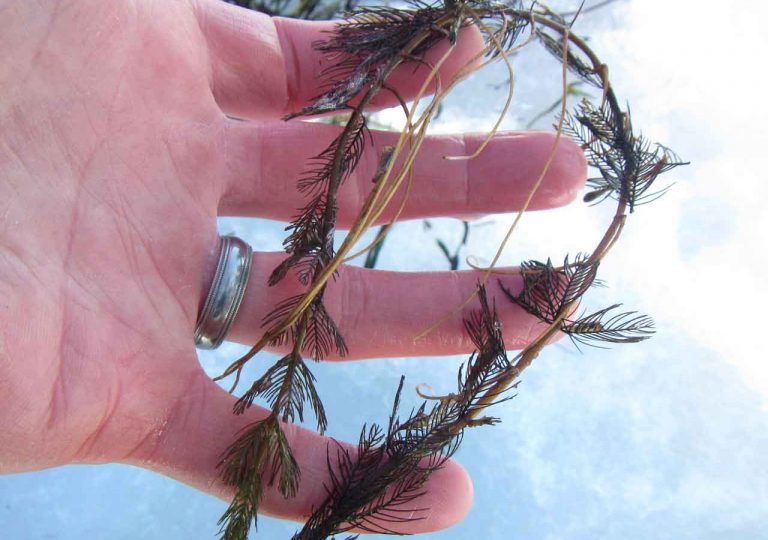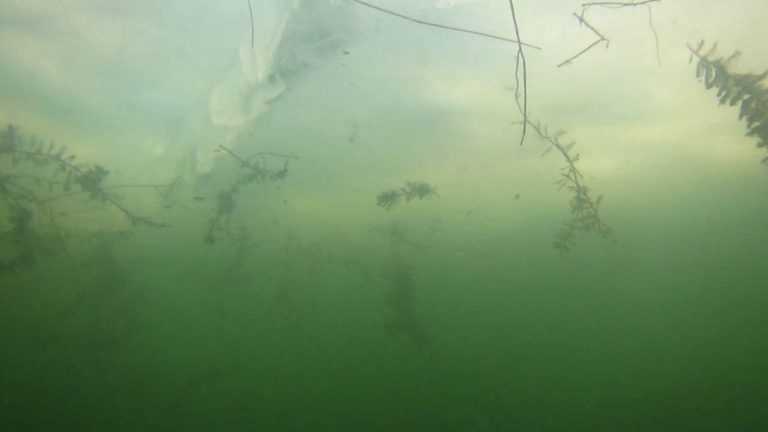You’ve got to be tough to survive a Wisconsin winter.
You’ve got to be tougher to survive it under ice.
Aquatic plants and animals native to Wisconsin’s lakes are adapted to deal with the colder temperatures and limited sunlight of winter. But what about the aquatic invasive species (AIS) introduced here from other places around the world?
According to Paul Skawinski, they’re tough, too.
And Skawinski should know. He’s the Statewide Citizen Lake Monitoring Network Educator with Extension Lakes and has seen the “land of mysteries” beneath the ice. During the winters of 2012–2015, Skawinski and a couple of aquatic biologist colleagues sunk a waterproof camera into fourteen lakes across central and northern Wisconsin. What he saw surprised him: lush greenery, many caddisfly larvae loping across the lake bottom, and the quick getaways of a darter and sculpin. These areas of live vegetation seemed to be attracting aquatic animals of all kinds, providing food and cover during the harsh winter season. He also identified a large bed of the invasive Eurasian watermilfoil, still photosynthesizing underneath the ice sheet in January. “It was still growing all the way from the bottom to the surface, and it just froze right in place.”
So how do aquatic plants and animals, both native and invasive, survive when temperatures drop and lakes freeze?
According to Skawinski, if they can move, they do. “Many of our aquatic animals are moving out to deeper water and living there for the wintertime.” Warm-water fishes swim to the deeper areas of the lake, where temperatures are warmest at 39° F. Zebra mussels, the striped invasive mollusk you’ll find encrusted on dock pilings and lake rocks throughout the summer, make a similar movement. Employing their strong foot, they inch toward deeper waters and away from the shallows, which are colder and risk freezing through.
Plants, lacking the luxury of mobility, have developed other mechanisms for overwintering in place. Sensing the changes in light and temperature that signal winter, many produce starch-packed turions, or buds, that drop to the bottom of the lake where they wait until spring to sprout roots and leaves. Others concentrate energy into their root systems or form tubers—think of potatoes—in the sediment, or send out seeds.
Some plants, like the invasive curly-leaf pondweed, simply prefer winter. The cold-water specialist grows primarily September–May when native species die back and go dormant. This ability to persist and thrive in cold temperatures gives curly-leaf an advantage come spring. With its ribbon-like leaves, it towers over and shades out native species as they wake up from winter.
Less Ice, More AIS
For both AIS and native species, ice and water temperatures shape the rhythms of growth and dormancy. What happens as winters warm and lakes experience later ice-on dates and fewer days of ice cover? Skawinski suspects more curly-leaf pondweed and Eurasian watermilfoil.
“Our native species are going dormant in September–October and they’re not sprouting again until April or May, but there are these other species that can tolerate the cold water and grow through that cold season. The more growth those species can put on, the more they’re going to compete with the native species as they try to grow again [in spring].”
Fewer days with ice also give cold-tolerant invasive species a leg up. Less ice means more sunlight, which means more growth. “They’re going to be able to put on a lot more biomass… and they’ll just be in better shape in the springtime to outcompete the natives even more.”
Stop the Spread, Even in Winter
Although the risk remains higher in summer, it is still possible to spread AIS in winter. Ice fishers jigging along the lake bottom may hook a rusty crayfish, and zebra mussel larvae could still be floating in the water. Skawinski says the biggest concern is Eurasian watermilfoil, which can reproduce and spread from a single fragment. “[The fragments] could come up in ice fishing holes; they could come up when an auger goes through and you could hook one of those, so the potential is there to still move viable pieces.”
When air temperatures are above freezing, ice fishers should clean augers and other equipment before using them in another waterbody. Although the lake may seem dead, Skawinski reminds us that it’s very much alive.
“There’s water down there, there’s plants, there’s animals and it’s just strange because it looks like you could be sitting in a cornfield and it could look pretty much the same, but underneath you is this whole underwater world that’s operating down there, just in a different way.”
For more information on AIS identification and monitoring, visit: https://www.uwsp.edu/cnr-ap/UWEXLakes/Pages/programs/clmn/AIS.aspx






